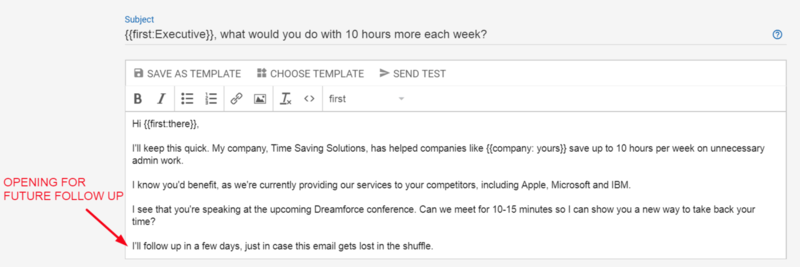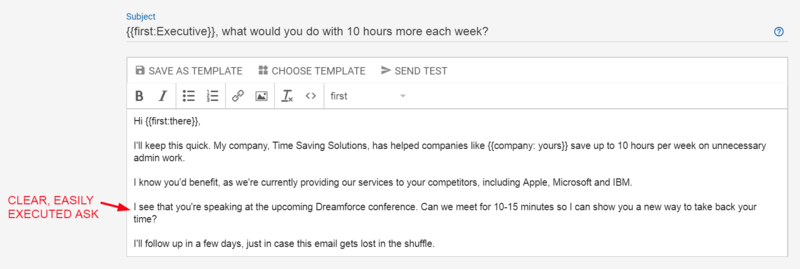We make initial judgements about people in nanoseconds. We take just 50 milliseconds to decide whether to stay on or to leave a new website. It takes up to 10 good experiences with a brand to make up for a bad one.
Simply put, first impressions matter and can make or break your ability to develop a strong relationship with a prospect and close a deal.
Whenever we’re confronted with something new, we quickly decide what we think of it – which is often outside of our conscious control. And that goes for the email messages we receive as well. That’s why, as a salesperson, it’s important that the introductory message in your cold email sequence hits the right marks right out of the gate.
You won’t get a second chance to make a first impression in your introductory email, so here are five best practices to help you get it right.
#1. Keep It Short
Why It Works: Email users receive an average of 88 emails per day. Yet, despite this, click-through rates for professional services emails average just 21.2 percent. The reality is that nobody has time to read the lengthy introductory message you’ve composed – no matter how critical you believe each detail to be.
According to Lead Fuze’s Justin McGill, “If your message is a burden for your prospect to read and/or respond to, they won’t. So keep it short and simple.”
One of the best ways I’ve found to keep email length in check is with a 3-sentence formula for cold sales emails that involves:
- The introduction
- A description of what you’re selling
- Your call-to-action (also known as your “ask”
That’s it. Short, simple and sweet. That said, keeping your message to three sentences is easier said than done. Start with what you have, and try to pare it down until just these three elements remain.
Data from Boomerang suggests that “the sweet spot for email length is between 50-125 words, all of which yielded response rates above 50 percent.” Ten-word messages, according to their survey, yield lower average open rates of 36 percent, while messages longer than 2,000 words declined to average open rates of 35 percent.
Example 1:
Hi Jamillah,
Intro: My name is Jon Benjamin, and I’ll keep this quick.
Describe: I’m the founder of a software tool that saves busy executives like yourself as many as 10 hours per week.
Ask: Could I have 10 minutes of your time next week for a personalized demo that’ll make clear why entrepreneurs like Gary Vaynerchuk, Tim Ferriss, and Malcolm Gladwell love our product?

#2. Make It Personal
Why It Works: Consider personalization a “must-do” in your cold email introductory messages. Here are some studies and statistics abound detailing the significant impact personalization has on open and reply rates:
- According to Adestra, personalized subject lines have open rates nearly 23 percent higher than non-personalized subject lines.
- Aberdeen reports that personalized email messages improve click-through rates by an average of 14 percent and conversions by 10 percent.
When you consider the psychology behind personalization, these performance statistics make sense. As Tucker Max shares in the Harvard Business Review, “The opportunity to help someone is very enjoyable for a lot of people — it may even qualify as a ‘want.’ By asking for help, you are giving them the chance to feel good about themselves. But make it easy for them.”
There are a number of different ways you can personalize your introduction email, including:
- Using name, title or company merge fields in your subject line
- Using merge fields to put the recipient’s name in the greeting
- Making sure the body copy of your message targets their specific needs
- Personalizing your call to action
That said, as you add personalization to your cold email campaigns, be careful not to overdo it. Reflektion’s Matt Helmke shares insight from a webinar he conducted with Forrester Principal Analyst Brendan Witcher, which cautioned brands to “be overt with the collection of customer data, but covert about communicating what you know about them.” According to Helmke:
“The best experiences should feel natural and non-intrusive to the customer; taking into account everything you know about them.”
How do you know if your personalization is too intrusive? Test different personalization approaches, and watch your open and reply rates. You’ll find the answers you need there. For more insights on crafting compelling cold emails, explore NetHunt’s guide on writing catchy cold emails.
Example 2:
Hi {{first name}},
I’ll keep this quick. My company, Time Saving Solutions, has helped companies like {{company name}} save up to 10 hours per week on unnecessary admin work.
I know you’d benefit, as we’re currently providing our services to your competitors, including Apple, Microsoft, and IBM.
I see that you’re speaking at the upcoming Dreamforce conference. Can we meet for 10-15 minutes so I can show you a new way to take back your time?
Opening for future follow-up: I’ll follow up in a few days, just in case this email gets lost in the shuffle.

#3. Focus On The Recipient
Why It Works: If you’ve ever gone on a first date or sat down for coffee with someone who spent the entire time talking about themselves and their problems, you know how important it is to focus on your recipients.
Nobody wants to open an email just to learn how their actions will benefit the sender. Instead, every part of your introductory message – from your opening line, to your description of your benefits, to your ask – needs to be focused on their pain points, not your needs.
Solid client relationships are built over time. Data gathered by Propeller suggests that the majority of all sales require five follow-ups (though it also notes that more than half of all salespeople give up after just one). Your introductory message is just the first step in this sequence. It’s to your advantage to focus on your recipients’ needs, lest they risk ending the relationship early. Discover more on this approach in NetHunt’s sales experts tips on cold emails.
The “Before-After-Bridge” cold email template – described below – is a great one to use here, as it emphasizes the recipient’s needs in three steps:
- Before: Describe what your reader’s life is like now
- After: Help them picture how your solution makes it better
- Bridge: Show them how you’ll take them from before to after
Example #3:
Hi Juan,
Before: If you’re like most busy executives, you know how frustrating it can feel to have your time wasted.
After: Our software changes that, freeing up as many as 10 hours per week for clients like Gary Vaynerchuk, Tim Ferriss, and Malcolm Gladwell.
Bridge: If you’d be willing to give me just 10 minutes of your time, I’ll show you how you can achieve the same savings with our innovative platform.
What’s the best time next week to reach out to you for a personalized demo?

#4. Minimize The Friction Of Your Ask
Why It Works: Asking too much from an introductory email is like proposing marriage on your first date. Keep two things in mind as you decide what to ask for in your message: make it clear and make it easy to execute.
Both of these are, to some degree, self-explanatory. A clear ask is more likely to be understood and followed through on than a complicated request or multiple asks. As Heather from SalesFolk shares:
“Instead of asking your prospect to schedule an open-ended call, set a time limit for your conversation. Asking your prospects for only 10 minutes of their time is a less threatening way to ask them to engage with you. It’s easier for your prospects to say yes when they know they won’t be stuck on the phone indefinitely.”
When you minimize the friction of your ask, you’re also – on a larger scale – getting recipients into a pattern of engaging with you. The consistency principle in psychology states: “I like to keep consistent what I think, say and do, and will change to ensure this is so.” If you can get recipients to engage with you once, their desire to remain consistent may lead them to engage with you further on larger future asks.
Example 4:
Merge Fields in Subject: Subject: {{first}}, what would you do with 10 hours more each week?
Hi {{first}},
Personalized Intro: I’ll keep this quick. My company, Time Saving Solutions, has helped companies like {{company: name}} save up to 10 hours per week on unnecessary admin work.
Competitor Mentions: I know you’d benefit, as we’re currently providing our services to your competitors, including Apple, Microsoft, and IBM.
Personalized CTA: I see that you’re speaking at the upcoming Dreamforce conference. Can we meet for 10-15 minutes so I can show you a new way to take back your time?
I’ll follow up in a few days, just in case this email gets lost in the shuffle.

#5. Open Up The Lines Of Communication
Why It Works: Your introductory email shouldn’t be the only cold sales message you send. Follow-up is critical, though it’s easy to overlook.
Take it from Steli Efti of close.io:
“It’s easy to focus on the initial contact. The first meeting. The email you’ve sent to someone important. You reach out to someone and then feel good about yourself. You’ve done your job, you’ve pitched and reached out. You’ve asked for a meeting/call/etc. Now all you have to do is sit around and wait for them to respond.”
Data shared on the Salesforce blog by Fergal Glynn suggests that it takes 6-8 touches to generate a viable sales lead. Add follow-up messages to your sequence, but also use your introductory message to set the expectation that more messages will be coming. Not only does doing so leverage the principle of consistency mentioned earlier, it makes it less jarring for recipients to hear from you again.
Example 5:
Hi {{first}},
I’ll keep this quick. My company, Time Saving Solutions, has helped companies like {{company: name}} save up to 10 hours per week on unnecessary admin work.
I know you’d benefit, as we’re currently providing our services to your competitors, including Apple, Microsoft, and IBM.
Clear, easily executed ask: I see that you’re speaking at the upcoming Dreamforce conference. Can we meet for 10-15 minutes so I can show you a new way to take back your time?
I’ll follow up in a few days, just in case this email gets lost in the shuffle.

Writing a Strong Cold Email Introduction
Keep in mind that the suggestions above should be taken as starting points only. Best practices may give you an idea of what will work. It’s up to you to test which specific elements are most compelling to your recipients.
Watch your reply rates, test different variables and be willing to experiment to drive ongoing cold email success.




